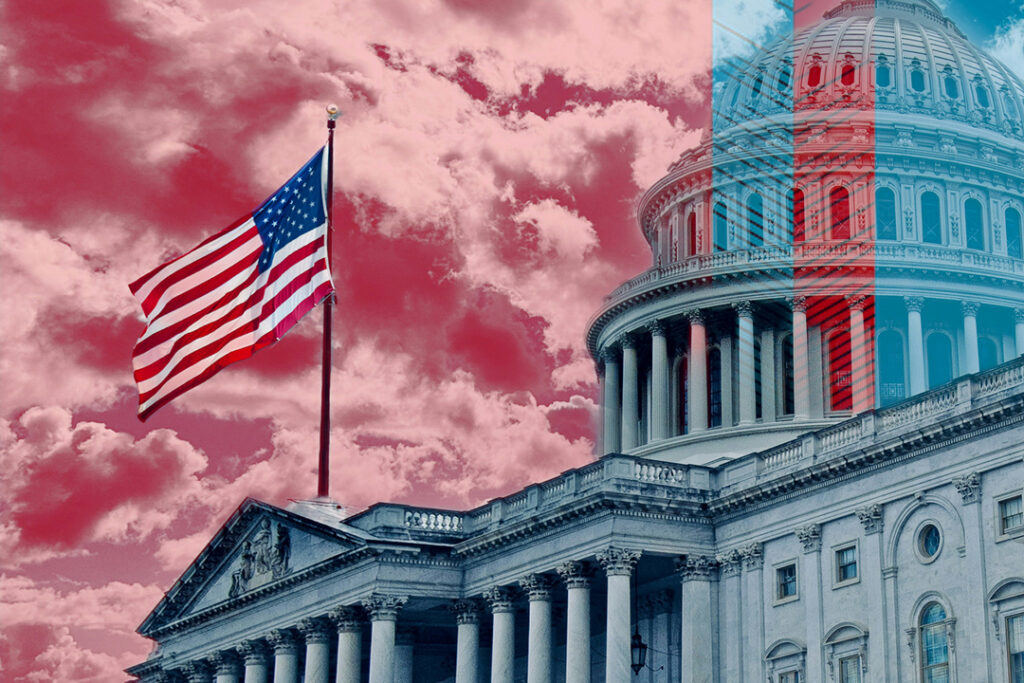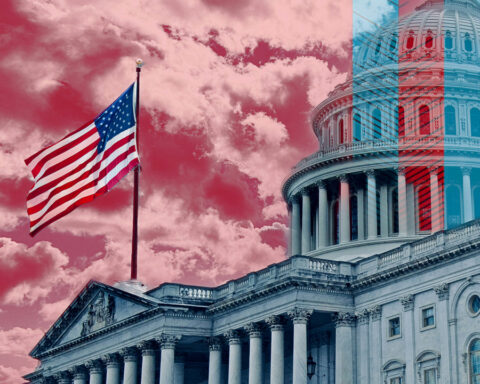The Great Misdirection
While Americans argued about pronouns and bathroom bills, the wealthiest 1% captured 32% of all new wealth created since 2020. While we debated whether the problem was “woke corporations” or “greedy capitalists,” those same corporations posted record profits during a period when most families struggled with inflation.
This isn’t coincidence. It’s the result of a political system that has mastered the art of misdirection, keeping us focused on cultural flashpoints while economic power concentrates upward at an unprecedented rate.
The real divide in America isn’t between left and right—it’s between those who own the game and those who are played by it. And right now, the house is winning.
The Theater of Left vs Right
Turn on any cable news channel, scroll through social media, or listen to political discourse, and you’ll find the same script: Democrats vs Republicans, liberals vs conservatives, progressives vs traditionalists. This binary framework has become so entrenched that we’ve forgotten it’s a relatively recent invention.
But here’s what’s remarkable: on the issues that most directly affect the concentration of wealth and power, the outcomes remain remarkably consistent regardless of which party controls government.
Consider these bipartisan achievements of the past two decades:
- Bank bailouts in 2008 and corporate bailouts in 2020, supported by both parties
- The revolving door between Wall Street and Treasury, seamless across administrations
- Military spending increases that benefit defense contractors, rarely questioned by either side
- Tax loopholes that persist through multiple “tax reform” efforts
- Regulatory agencies staffed by former industry executives, regardless of party
Meanwhile, the issues that dominate headlines—abortion rights, gun control, immigration—while genuinely important to many Americans, don’t threaten the fundamental economic structure. They’re perfect culture war topics: emotionally charged, deeply personal, and crucially, they don’t affect quarterly earnings reports.
Understanding the Real Divide
When we talk about “top vs bottom,” we’re not just discussing income inequality—though the numbers are staggering. We’re talking about fundamentally different relationships to power, information, and opportunity.
The Top operates in a world where:
- Mistakes are socialized, profits are privatized
- Regulations are written by former colleagues
- Political access is purchased, not earned
- Information flows through private networks before public release
- Risk is managed through diversification and insider knowledge
The Bottom operates in a world where:
- Individual responsibility is absolute
- Regulations are enforced selectively
- Political influence comes through voting, if at all
- Information arrives through filtered, commercialized media
- Risk is managed through savings and insurance, when possible
This isn’t about vilifying success or wealth creation. It’s about recognizing that when the rules of the game are written by the players, the game stops being fair.
The Winning Playbook
How does the top maintain its position while democracy theoretically gives the bottom the numbers to change things? The playbook is surprisingly straightforward:
Divide and Conquer: Keep the bottom fighting among themselves over issues that don’t threaten top-level interests. Rural vs urban, educated vs working class, different ethnic groups competing for limited resources—all while the resource allocation decisions happen in boardrooms and private clubs.
Complexity as Camouflage: Make the systems of power so complex that they’re difficult to understand and challenge. Financial derivatives, regulatory frameworks, lobbying networks—all designed to be opaque to outsiders while navigable for insiders.
Capture the Referees: Staff regulatory agencies with former industry executives. Fund think tanks that produce friendly research. Create revolving doors between government and industry so that today’s regulator is tomorrow’s consultant.
Control the Narrative: Own or influence media outlets. Fund academic research. Create astroturf movements that appear grassroots but serve elite interests. Shape the terms of debate so that certain questions are never asked.
Legal Moats: Use the legal system to create barriers to entry, protect incumbents, and ensure that breaking the rules is simply a cost of doing business. When fines are smaller than profits, they become licensing fees.
The Historical Pattern
This dynamic isn’t new, but it has intensified dramatically since the 1970s. The post-war period saw the strongest middle class in American history, built on policies that constrained capital and empowered labor. Union membership peaked, CEO-to-worker pay ratios were reasonable, and social mobility was a realistic aspiration for most families.
The turning point came with the “Powell Memo” of 1971, when future Supreme Court Justice Lewis Powell outlined a strategy for business to reassert political influence. The memo, written for the U.S. Chamber of Commerce, called for a coordinated effort to influence universities, media, courts, and politics to shift the balance of power back toward capital.
The strategy worked. Over the following decades:
- Union membership collapsed from 35% to 10% of the workforce
- CEO pay increased from 20 times average worker pay to over 300 times
- Financial sector profits grew from 10% to 40% of all corporate profits
- Political spending by corporations increased exponentially
Internationally, we can see what happens when societies successfully resist this pattern. Countries like Denmark, Germany, and South Korea have maintained strong middle classes by preserving institutions that balance power between capital and labor.
The Cracks in the System
But something is shifting. Across the political spectrum, people are beginning to recognize that the traditional left-right framework doesn’t explain their lived experience.
On the Right: The Trump phenomenon, whatever one thinks of Trump personally, represented a break with traditional Republican orthodoxy on trade, immigration, and foreign policy. His appeal came partly from recognizing that globalization had created winners and losers, and that the Republican establishment had been on the wrong side of their own voters’ interests.
On the Left: Bernie Sanders’ campaigns similarly broke with Democratic orthodoxy, focusing on class issues rather than identity politics. His message resonated because it named the real source of economic anxiety: a rigged system rather than personal failures.
Across the Spectrum: Issues like opposition to endless wars, skepticism of big tech monopolies, anger at financial sector bailouts, and concern about government surveillance unite people who agree on little else.
The yellow vest protests in France, the anti-establishment movements across Europe, and the growing labor organizing in the U.S. all suggest that people are beginning to identify their real interests rather than their assigned tribal loyalties.
What This Means for Your Life
Understanding the top-bottom dynamic isn’t just intellectual exercise—it has practical implications for how you navigate an increasingly unequal society.
Financially: Recognize that traditional advice about saving and investing assumes a stable middle-class trajectory that’s increasingly unavailable. The rules of wealth building have changed, and they favor those with existing capital and insider knowledge.
Politically: Look beyond party labels to follow the money. Which policies actually transfer wealth upward? Which ones create genuine opportunity for mobility? The answers often don’t align with traditional partisan expectations.
Professionally: The “gig economy” and “entrepreneurship” are often sold as liberation, but they frequently represent the transfer of risk and responsibility from institutions to individuals. Understanding this doesn’t mean avoiding these arrangements, but entering them with clear eyes.
Socially: The most important political alliances may be with people who share your economic interests rather than your cultural preferences. A working-class conservative and a working-class progressive have more in common economically than either has with the wealthy members of their respective parties.
Breaking the Pattern
The good news is that when people recognize the real dynamics at play, they can be remarkably effective at organizing for change. History shows that concentrated power can be challenged when the bottom finds ways to coordinate.
Start Locally: Local politics is where individual voices carry the most weight and where the connection between policy and daily life is most direct. School boards, city councils, and state legislatures are where many of the rules that govern daily life are actually made.
Build Bridges: Look for opportunities to work with people across traditional political divides on issues of common interest. Criminal justice reform, antitrust enforcement, and infrastructure investment often create strange bedfellows.
Follow the Money: Develop literacy about how economic power actually works. Understand your local economy, who owns what, and how decisions get made. Knowledge is power, and the top maintains its position partly through information asymmetries.
Support Independent Media: The consolidation of media ownership is part of the top-bottom dynamic. Support journalism that isn’t dependent on corporate advertising or billionaire owners.
Organize Economically: Remember that you have economic power as a worker, consumer, and investor. Labor organizing, consumer boycotts, and shareholder activism can all be effective tools for change.
The Path Forward
The top-bottom framework isn’t about creating new divisions—it’s about recognizing the divisions that already exist and have been obscured by other conflicts. It’s about understanding that the real political question isn’t whether you’re on the left or right, but whether you’re on the side of concentrated power or distributed opportunity.
This doesn’t mean abandoning all other political concerns. Issues of identity, culture, and values matter deeply to people and deserve serious attention. But it does mean recognizing that many of these issues are shaped by underlying economic structures that make them harder or easier to address.
The wealthy didn’t create inequality by accident—they created it through coordinated political action over decades. The bottom can respond the same way: through coordinated political action that prioritizes economic democracy over cultural performance.
The first step is seeing the game for what it is. The second is deciding whether you want to keep playing by their rules or start writing your own.
Take Action
This Week:
- Research who funds your local politicians and what policies they’ve supported
- Identify one local issue where economic interests cross traditional political lines
- Find one source of news that isn’t owned by a major corporation
This Month:
- Attend a city council or school board meeting
- Join or support an organization working on economic justice issues
- Start a conversation with someone who disagrees with you politically but shares your economic interests
This Year:
- Vote in every election, including primaries and local races
- Support businesses and organizations that align with your values
- Develop skills that increase your economic independence and security
The game is rigged, but it’s not fixed. The house wins because most people don’t realize they’re playing. Once you see the real game, you can start playing to win.







